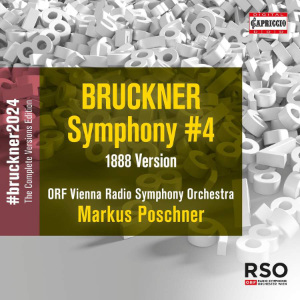
Anton Bruckner (1824-1896)
Symphony No 4 in E-flat major (1888) ‘Romantic’ (ed. 2004 Korstvedt)
ORF Vienna Radio Symphony Orchestra/Markus Poschner
rec. 2021, Radiokulturhaus, Vienna, Austria
Bruckner 2024 – The Complete Versions Edition
Capriccio C8085 [62]
I previously reviewed Poschner’s recording of Benjamin Korstvedt’s edition of the 1876 version of the original score of the ‘Romantic’, finding it admirable but still a little too hurried; I was more impressed by his previous recording of the 1878-80 version (review). This latest instalment in his Complete Versions Edition presents what is now believed to be Bruckner’s own, final thoughts on the symphony rather than the result of undue interference from or influence by any of his acolytes. It matches the 1878-80 recording in quality.
The opening horn calls seem to me to be ideally paced and weighted; the atmosphere is relaxed and bucolic and I like Poschner’s control of dynamics. He generates momentum skilfully over the first six minutes before the mysterious central section which reiterates the opening call and develops into the stormy “Bruckner rhythm” motif. If I have any criticism, it is that the solo horn tone could be just a tad cleaner, fuller and more forward; it is occasionally too reticent and set back in the sound picture. Otherwise, balances are very natural, even if some recordings aim for less of a concert hall acoustic and highlight more vividly, for example, the string articulation of the semiquavers in the third thematic group with which the movement concludes – but there is certainly no understatement of the horn chorale in the final bars, which are rousingly delivered.
The Andante is elegantly and delicately played; the muting of strings in some passages in this movement, adding to its sense of greater reserve and the conclusion has more of Mahler’s “Bruder Jacob” funeral march about it. The Scherzo, too, differs from earlier versions in that (quoting from Paul Harkshaw’s note) “the end of the opening section of the Scherzo elides quietly into the rustic trio and the return of the opening section after the Trio is cut by 65 measured so a decisive fortissimo cadence is reserved for the end of the movement”. This essentially simplifies the music. Changes to the Finale are less apparent to the casual listener, being mostly concerned with some cuts such as the excision of the first thematic group and alterations to orchestration; Poschner establishes a fine balance between the serious, grandiose outbursts and the more idyllic, rustic sections but the mood is prevailingly sombre. The otherworldly coda is beautifully gauged bringing a finely controlled account to an appropriately imposing conclusion – one of the greatest in the Bruckner canon, regardless of edition.
I cannot help but wonder, however, whether the average Bruckner punter – rather than academics and musicologists – cares about – or even notices – the minutiae of the differences between the various versions of the Fourth Symphony sufficiently to prompt purchase of issues such as this, especially as in a broad sense it is a reversion, being closer to the Gutman publication of the score 1889, revised and corrected 1890, the version made famous in recordings by Furtwängler and Knappertsbusch – although Furtwängler omits the ‘fade-down’ to the Trio in the first appearance of the scherzo. We also already have Jakub Hrůša’s account of this included in his “The 3 versions” which uses the same Korstvedt edition, so are now spoiled for choice.
Ralph Moore
Help us financially by purchasing from





















